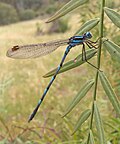Austrolestes
Appearance
| Austrolestes | |
|---|---|

| |
| Blue Ringtail (Austrolestes annulosus) | |
| Scientific classification | |
| Domain: | Eukaryota |
| Kingdom: | Animalia |
| Phylum: | Arthropoda |
| Class: | Insecta |
| Order: | Odonata |
| Suborder: | Zygoptera |
| Family: | Lestidae |
| Genus: | Austrolestes Tillyard, 1913[1] |
| Type species | |
| Austrolestes cingulatus | |
Austrolestes is a genus of medium to large-sized damselflies in the family Lestidae.[2] Austrolestes damselflies sit with their wings folded completely back.[1] Males are usually bright blue and black, the females duller. Members of this genus are found in Australia, New Zealand and South Pacific islands.
Species
[edit]The genus Austrolestes includes the following species:[3]
| Male | Female | Scientific name | Common Name | Distribution |
|---|---|---|---|---|
| Austrolestes aleison Watson & Moulds, 1979 | Western ringtail | south-western Australia | ||
 |
 |
Austrolestes analis (Rambur, 1842) | Slender ringtail | South Australia, Victoria, New South Wales and Tasmania. |
 |
 |
Austrolestes annulosus (Selys, 1862) | Blue ringtail | Australia |
| Austrolestes aridus (Tillyard, 1908) | Inland ringtail | Australia | ||
 |
 |
Austrolestes cingulatus (Burmeister, 1839) | Metallic ringtail | Tasmania, Victoria and eastern New South Wales |
 |
 |
Austrolestes colensonis (White, 1846) | Blue damselfly, kekewai | New Zealand |
 |
Austrolestes insularis Tillyard, 1913 | Northern ringtail | northern Australia | |
 |
Austrolestes io (Selys, 1862) | Iota ringtail | south-western Australia and south-eastern Australia | |
 |
 |
Austrolestes leda (Selys, 1862) | Wandering ringtail | eastern Australia |
 |
Austrolestes minjerriba Watson, 1979 | Dune ringtail | northern New South Wales and southern Queensland | |
 |
 |
Austrolestes psyche (Hagen in Selys, 1862) | Cup ringtail | south-eastern Australia |
Etymology
[edit]The genus name Austrolestes is derived from the latin word auster meaning south wind, hence south; and the damselfly genus Lestes, which is from the Greek word λῃστής meaning a robber.[1][4] In 1913, Robin Tillyard described the genus Austrolestes as having characters similar to the very large genus Lestes, which, unlike Austrolestes, sit with their wings outspread.[1]
References
[edit]Wikimedia Commons has media related to Austrolestes.
Wikispecies has information related to Austrolestes.
- ^ a b c d Tillyard, R.J. (1913). "On some new and rare Australian Agrionidae (Odonata)". Proceedings of the Linnean Society of New South Wales. 37 (1912): 404–479 [421]. doi:10.5962/bhl.part.22352 – via Biodiversity Heritage Library.
- ^ "Genus Austrolestes Tillyard, 1913". Australian Faunal Directory. Australian Biological Resources Study. 2012. Retrieved 4 April 2017.
- ^ Martin Schorr; Martin Lindeboom; Dennis Paulson. "World Odonata List". University of Puget Sound. Archived from the original on 28 August 2010. Retrieved 11 August 2010.
- ^ Endersby, I. (2012). "Watson and Theischinger: the etymology of the dragonfly (Insecta: Odonata) names which they published". Journal and Proceedings of the Royal Society of New South Wales. 145 (443 & 444): 34–53. ISSN 0035-9173 – via Biodiversity Heritage Library.
- Günther Theischinger; John Hawking (2006). The Complete Field Guide to Dragonflies of Australia. CSIRO Publishing. ISBN 0-643-09073-8.
- Annette Walker; et al. (2000). The Reed Handbook of Common New Zealand Insects. Raupo Publishing (NZ). ISBN 0-7900-0718-5.
